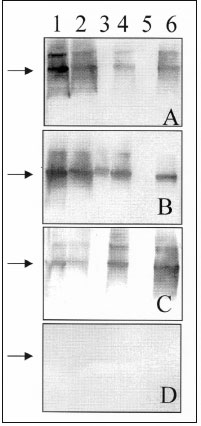Volume 4, Number 1—March 1998
Dispatch
Bayou Virus-Associated Hantavirus Pulmonary Syndrome in Eastern Texas: Identification of the Rice Rat, Oryzomys palustris, as Reservoir Host
Figure 3

Figure 3. Western blot assay for detecting IgG antibodies in patient and rodent blood samples. A 1:500 dilution of serum was used to probe Western blots containing equimolar amounts of recombinant-expressed N antigens of various hantaviruses: 1) Bayou; 2) Muleshoe; 3) Puumala; 4) Rio Mamoré; 5) Seoul; and 6) Sin Nombre. Serum samples are directed against specific hantaviruses as verified by reverse transcription-PCR and sequence analyses: (A) patient T/Tx, Bayou virus; (B) Bayou virus-seropositive Oryzomys palustris specimen #505, collected in Jefferson County, Texas; (C) a Sin Nombre-seropositive deer mouse, collected in California; (D), a negative control (hantavirus-seronegative) deer mouse. Antibodies bound to the solid-phase antigens were detected with alkaline phosphatase-conjugated anti-human IgG (A) or with anti-Peromyscus leucopus IgG (B-D). The arrow indicates the migration of the full-length T7-viral N antigen, ~55kDa.